January/February 2025
From the Bell Tower
Though I daresay the diaries of Rev. Benjamin J Armstrong (Vicar of East Dereham 1850-88)
will be known to some readers, they are new to me and proved to be a breath of fresh air over the
festive season. The following extracts come from the 1949 and 1963 separate editions of his diaries
made by his grandson, also a Norfolk priest. I assume they are now out of copyright but if not, I
trust we are excused dipping into the books and reproducing those few entries pertinent to the
Upper Wensum Benefice. Almost all the names mentioned are of other local clergy, being high
churchmen involved with reorderings of their churches. “Bathurst’ was the surname of the Bishop
of Norwich who died in 1837 and so would suspect some family connection, but don’t know quite
what as yet. The diaries as a whole give a wonderful history, as it happened both home and abroad
and not just parochial and I would recommend them most heartily!
Ryburgh:
July 20th 1860- Drove to the reopening of the church at Ryburgh, a village 10 miles off. Mr Tatham
is a good Churchman, and the work, though severely simple in character, is well done. Chairs are
introduced. The Bishop of Norwich [J.T.Pelham] preached. He promised to preach at Dereham in
the autumn.
July 26th 1861- Preached at Evensong at Ryburgh. When we got there, there were 300 of the
villagers having tea in a barn, the tables being presided over by the Rector and several neighbouring
clergy. After tea a circle was made on the lawn and the party was addressed on missionary subjects
by Mr Sweet [Colkirk] and Mr Moxon [Hempton]. The church at Evensong was crowded and was
lighted by iron movable Gothic standards, Here was an example of what zeal can effect in an
unpromising sphere, and when people’s hearts are really in the work. The service was divided
between the Rector (Mr Tatham) and Mr Moxon.
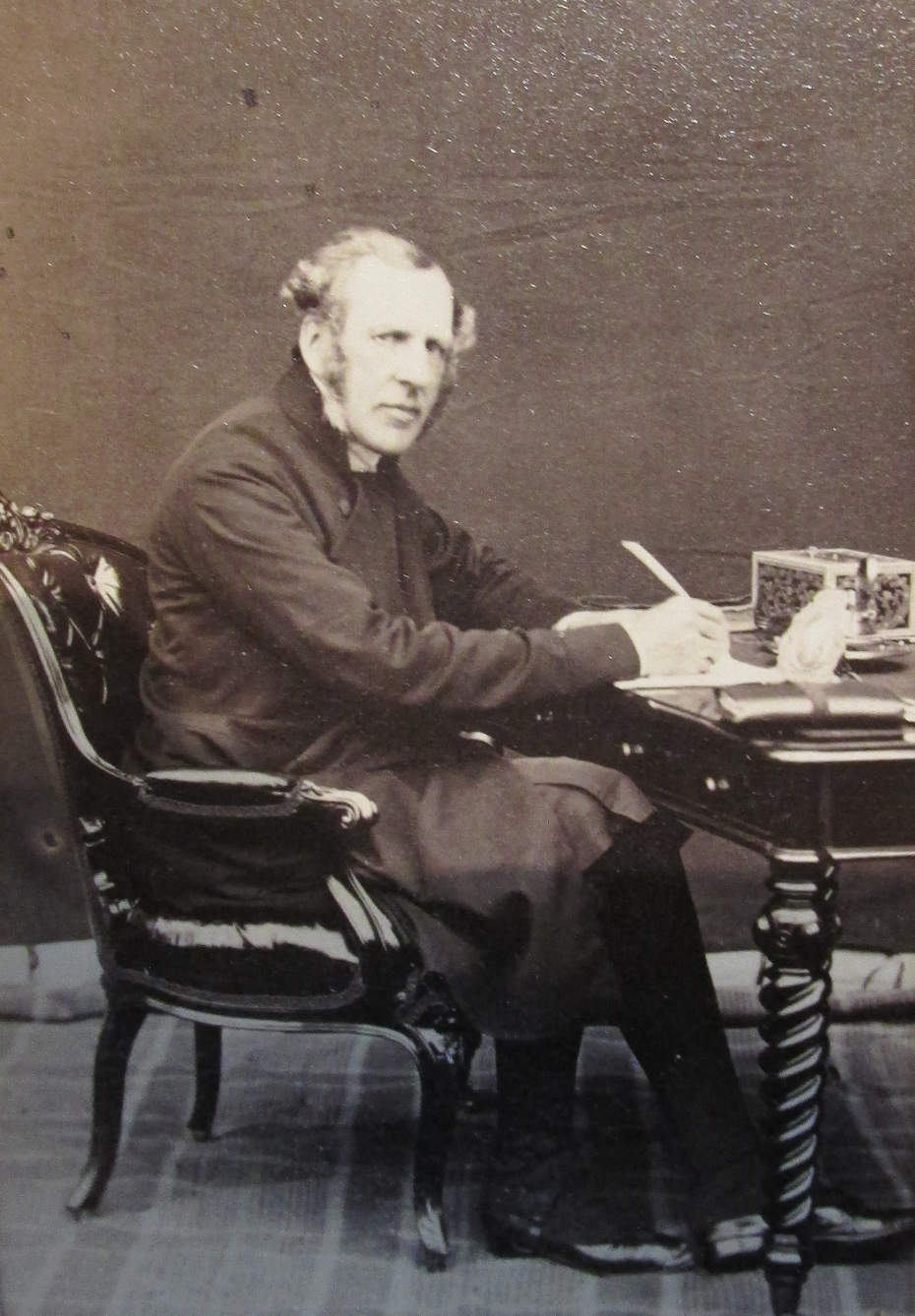
Bishop (John Thomas) Pelham of Norwich (circa 1865)
Colkirk:
March 19th 1858 - By rail to Ryburgh Station to preach at Colkirk at the request of the new vicar,
Mr. Sweet. He met me at the station in the queerest basket conveyance that I ever saw, with a white
horse which liberally covered me with his changing coat. There was an excellent and attentive
congregation. Returned to Dereham the next day.
December 8th. 1867 - Preached at Colkirk, it being the Annual Dedication festival of that parish.
Never had a worse drive, in the teeth of hail, wind and snow. Service Gregorian.
Gateley:
September 5th 1858 - Drove to Gately to take the duty for Mr. Smith. It is a wretched pewed-up little
church with the most diminutive organ I ever saw, and as miserable in sound as in size
Whissonsett:
August 23rd 1867 -Rode to call on Mr. Lane, the new Rector of Whissonsett. This church and rectory
were formerly in the most miserable condition, but both are now restored. When I preached here
some years ago the people could not be got to church – the idea had died out. Mr Lane says they
now come in crowds and the farmers are wanting the few high pews which yet remain to be
forthwith removed.
February 28th 1868 – Preached at the first of a course of Mission Services at Whissonsett. During
my sermon I was so often interrupted by a member of the congregation that I began to think the he
must be one of those wretched beings sent out by the Church Association to interrupt the service in
“Ritualist” churches. Indeed, I had to expostulate with him from the pulpit, but it soon became
evident that he was drunk, and was prudently conducted out of the church by his friends.
March 10th 1868 – At an E.C.U. meeting Mr Lane, the new Rector of Whissonsett, handed me a
paper of apology signed by the man who interrupted the service of February 28th
.
January 5th 1869 – A day or so back my elder boy and I rode to Whissonsett to call on the rector. He
showed his banners, eucharistic vestments and scarlet cassock and laced cotta for the thurifer! Who
could ever suppose that such things would be used again and in the heart of Norfolk! The object of
the Ritualists is to make our services as glorious and beautiful as any in the world. But the public
feeling is too strong for the attempt to succeed. It is thought that legislation may be brought to bear,
in which case the excitement, which is great enough already, will be fearful.
January 4th 1870 – Dined at Mr Lane’s Whissonett Rectory. The Lanes bear the Royal Arms impaled
with the motto Garde le Roy from Charles II having ridden in disguise with one of their ancestors
on a pillion, and so escaped the Roundheads
February 10th 1871 – “It never rains but it pours”. Unusually dull as this winter has been I have
dined out three days in succession – on Tuesday at Bathursts’, on Wednesday at the Collisons’, and
yesterday at the Legges’ at Elmham to take part in a Penny Reading. As usual, however, the music
put the reading out of countenance and the singing of “Medicine Jack” in character, by young
Martin of Whissonsett was relished more than all the rest.
Horningtoft:
April 20th 1870 - Went to the reopening of Horningtoft Church, after being all but rebuilt. The
difference in the church now to what it was when I preached there many years ago is striking
indeed. The ancient screen is repainted and gilded; there are beautiful seats; a proper altar with
Cross, vases and candlesticks. The choristers having three banners, and clergy, all in white stoles,
proceeded from a neighbouring farmhouse singing “Onward, Christian Soldiers.” The collection
amounted to £17. It is wonderful what can be done in a small place where the incumbent has taste
and energy and where there are no obstructives to hinder!
Brisley:
May 8th. 1860 -Dined with Smith of Brisley and met, among others, K Digby. Mr Digby said that he
had seen a letter from Vaughan’s wife repudiating the idea that her husband had declined the
Bishopric on account of her meditated secession to Rome. “She would rather go to the stake first”.
He also said that it is not improbable that the Bishop of Norwich may be translated to York. This I
should not greatly regret.
Shereford: No entries. Dunton: No entries. Oxwick: No entries.
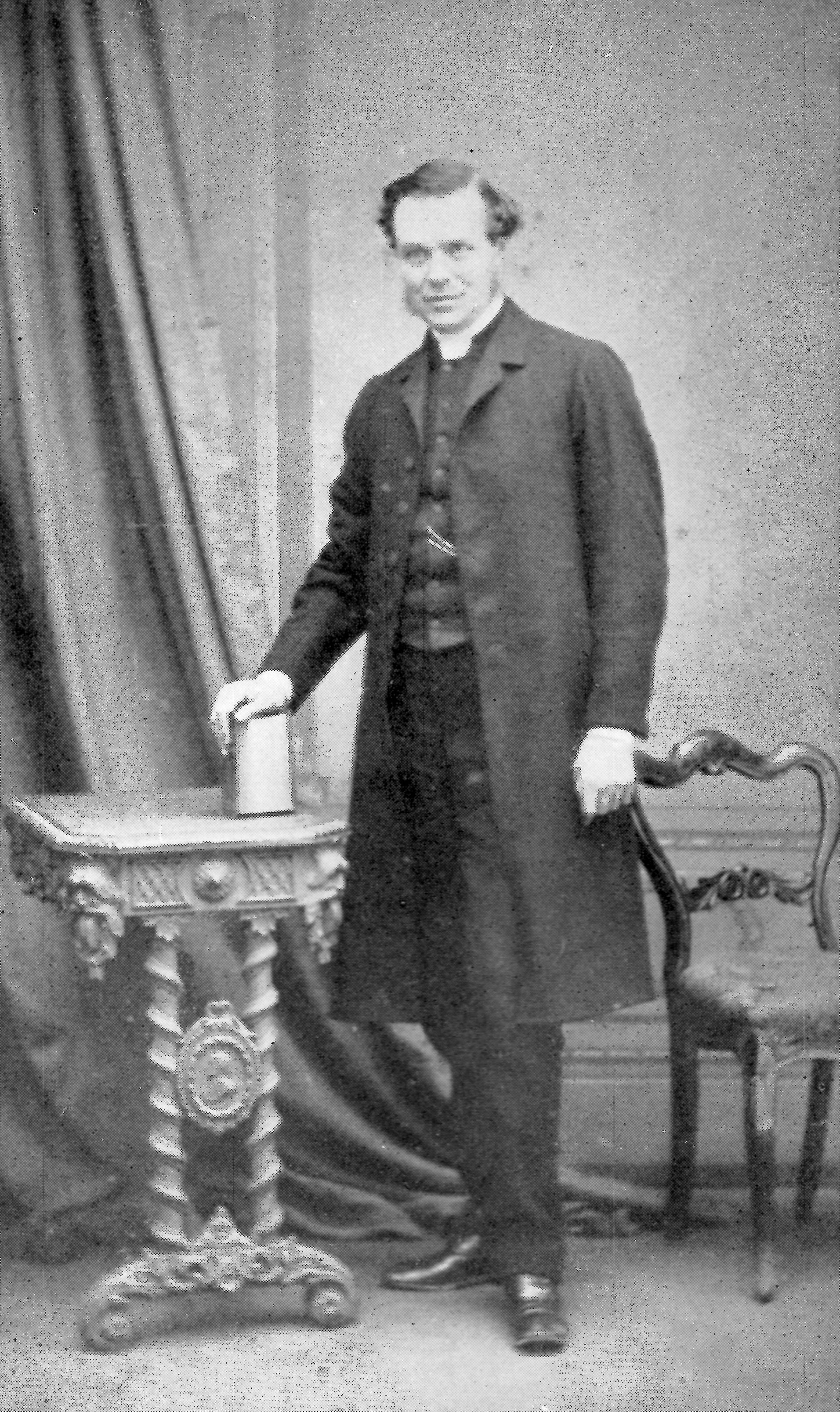

The diarist himself: the Revd. Benjamin John Armstrong. Vicar of Dereham and the Revd. George Edmund Tatham. Rector of Great Ryburgh
P.S. Does anyone know of images of the following Reverend Gentlemen as mentioned in the extracts
above. If so please get in touch?:[James Bradby]Sweet (Colkirk), [John] Smith (Brisley /Gateley), [Francis Charles de Lona] Lane
(Whissonsett), [Charles St.Denys]Moxon (Hempton), [Augustus George] Legge (North Elmham),
[Kenelm Henry] Digby (Tittleshall), [Henry] Collison (East Bilney with Beetley).
**********
March 2025
From the Bell Tower
At the outset, the author of this column would like to say he wishes to be disassociated from the
unkind and outspoken views of the Revd. Benjamin Armstrong regarding Gateley Church expressed
in last month’s magazine. Looked at with the benefit of hindsight, it is precisely the lack of
Victorian ecclesiastical restoration zeal as personified by Armstrong, Tatham, Sweet and other local
clergy of the era that we still have the jewel that is Gateley St Helen’s today.
Of course iconoclasm didn’t begin with the Victorian reforms within the C.of E. and it certainly
wasn’t George Tatham who was solely responsible for all the changes that have taken place here at
St Andrew’s, in fact generation after generation have given St Andrew’s a makeover in accordance
with the contemporary use, fashion, patronage, whimsy, vanity, and duty amongst others, not to
mention the finance to be able to do the job: Plus ça change!
Last year I wrote about the uncovering of a former north door to the nave, discarded over time,
filled in and all but forgotten. For me of course it was the discovery of the year and something I
thought would be hard to better when trying to unravel the earlier iterations of the church. I am
happy to say though that I think I was wrong to be so easily “laurel resting” and I will explain:
The ringing chamber in the tower is quite distinctive because of its "Saxon" features, which to the
majority of the world are out of sight and out of mind; that is to say the triangular doorway onto the
nave behind the organ and the narrow west window opening, that is splayed to more than double its
width on the inside. Moreover, there is one other lesser known feature in the ringing chamber and
something that is always in view on the wall opposite the Tenor ringer. These are the scars on the
wall caused by the removal (by demolition or collapse?) of a spiral stair that once was constructed
within the tower.
It was on our recent Winter Wander that we visited Yaxham with its round tower and ring of six
bells. The first thing that caught my attention on arrival was the North doorway to the nave with it’s
door, though unused, still in place and surrounded by a very similar moulded arch to that which was
uncovered last year at St Andrew’s. As our visit continued other similarities between our two
churches kept occurring. Just before we began our ringing I was able to go up the tower with the
intention of taking a look at the bells, which in the event I never got to see because this is the only
place I have seen a spiral stair inside a round tower before. Unlike Ryburgh, the bells there are rung
from the ground floor and the spiral stair is still in use being the only way to get up to the room
above i.e. the equivalent space to our ringing chamber. Ringers climb a lot of spiral stairs and this
therefore seemed unremarkable except for the very poor state of its treads which required a deal of
care to climb. On arriving at the top, I was instantly struck by the similarity to our tower at this
level. The opening through to the nave which has a semicircular opening on the nave side was filled
up inside the tower with rough infill and a rectangular wooden door. Opposite on the west wall was
a splayed window just like Ryburgh though a little less cared-for, being out of sight and an
otherwise unused space: the bells, as at Ryburgh being hung on the floor above. The terminating
walls of the stair turret were capped off in this chamber and I thought “so that’s what Ryburgh must
have been like back in the day” This brought the spiral stair at St Andrew’s back into focus and I
was very soon thinking that our spiral could have been, dare I say, was in fact very different to
Yaxham. I took some photos of my very brief tower trip and on returning, started to give the whole
idea of the Ryburgh spiral some serious investigative thought, very quickly realising that a spiral is
not just a spiral. At this point I also understand that I could quite easily become a spiral bore and so
will finish with some images of what I have described above and return next month to satisfy any
curiosity you have experienced after reading this when I will try to describe what I think no longer
survives from what is left behind that can be seen!

North door at Yaxham with moulded arch as at Ryburgh
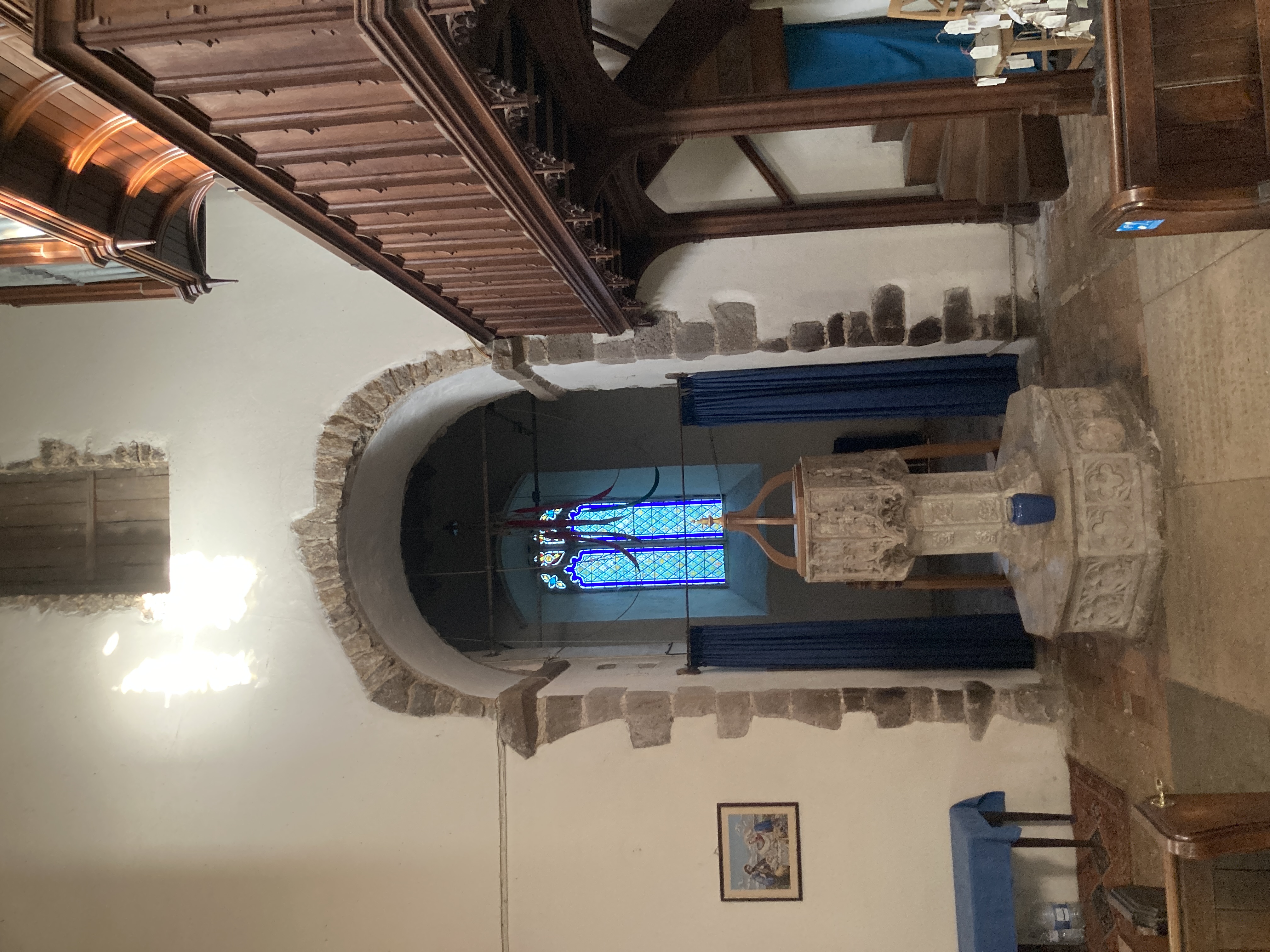
Tower Arch and Doorway above seen from the nave at Yaxham
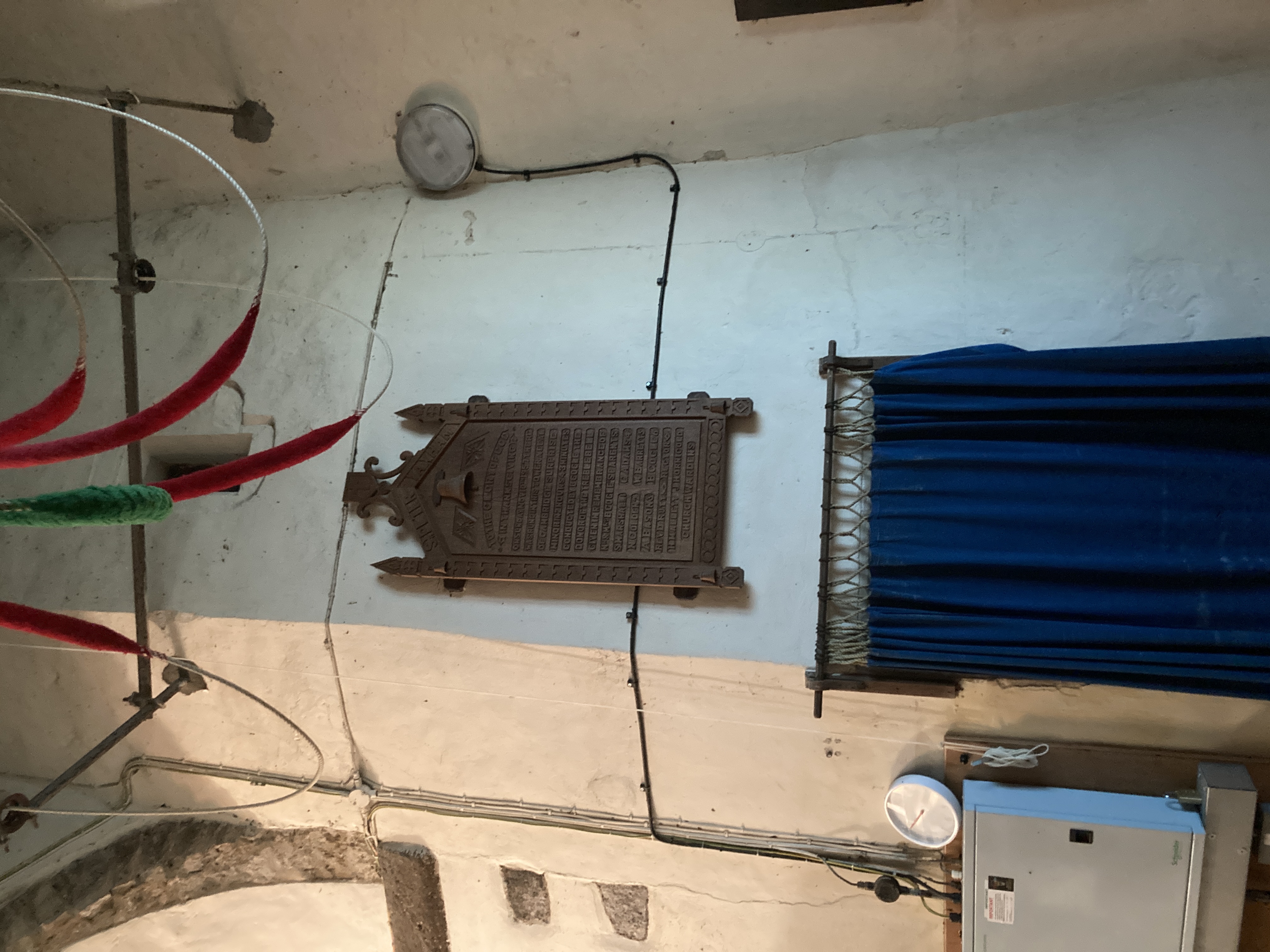
Ground floor entrance to spiral stair behind the curtain at Yaxham

Upper Nave doorway at Yaxham

Upper Nave doorway at Ryburgh

West window at Yaxham
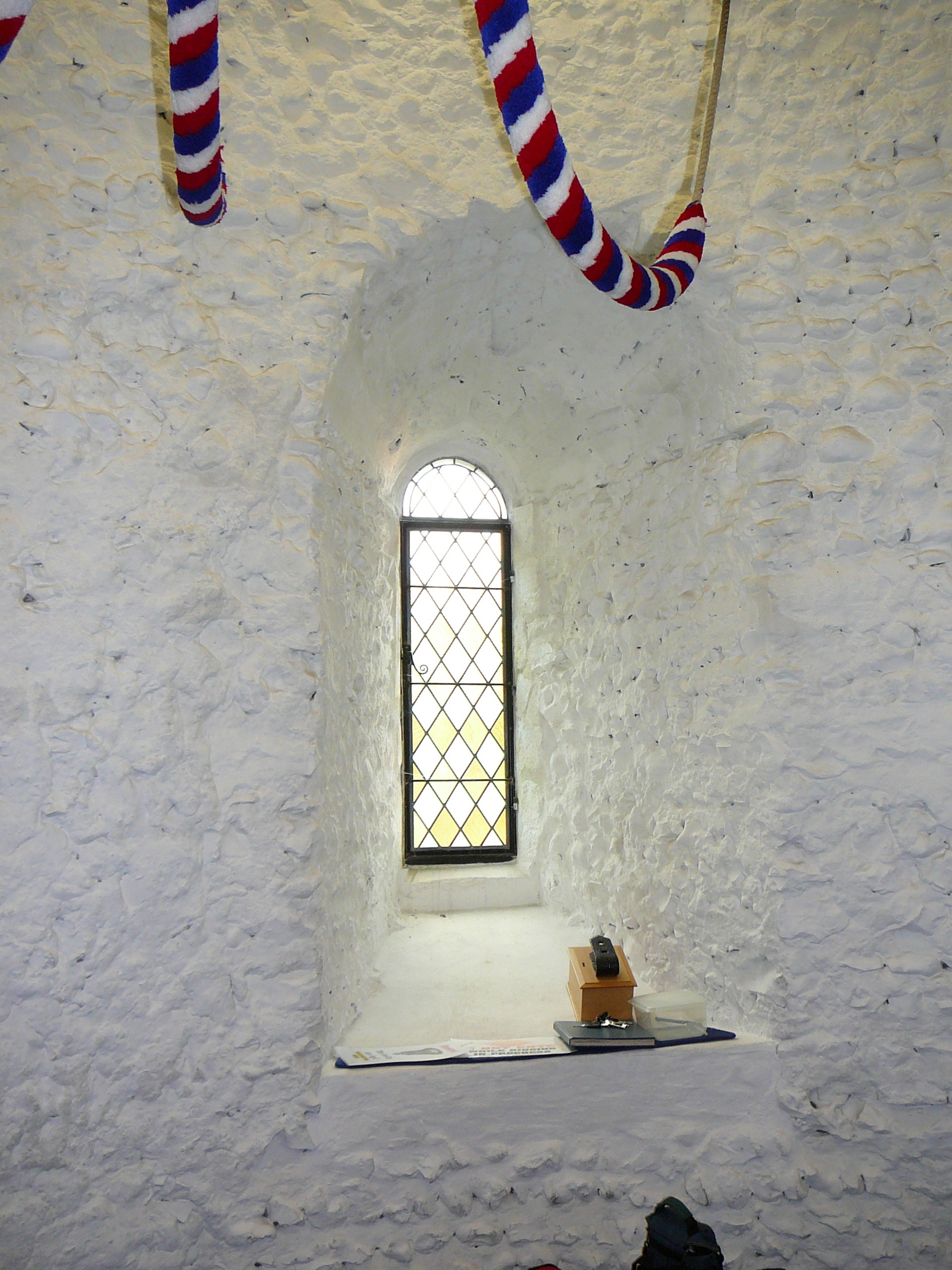
West window at Ryburgh
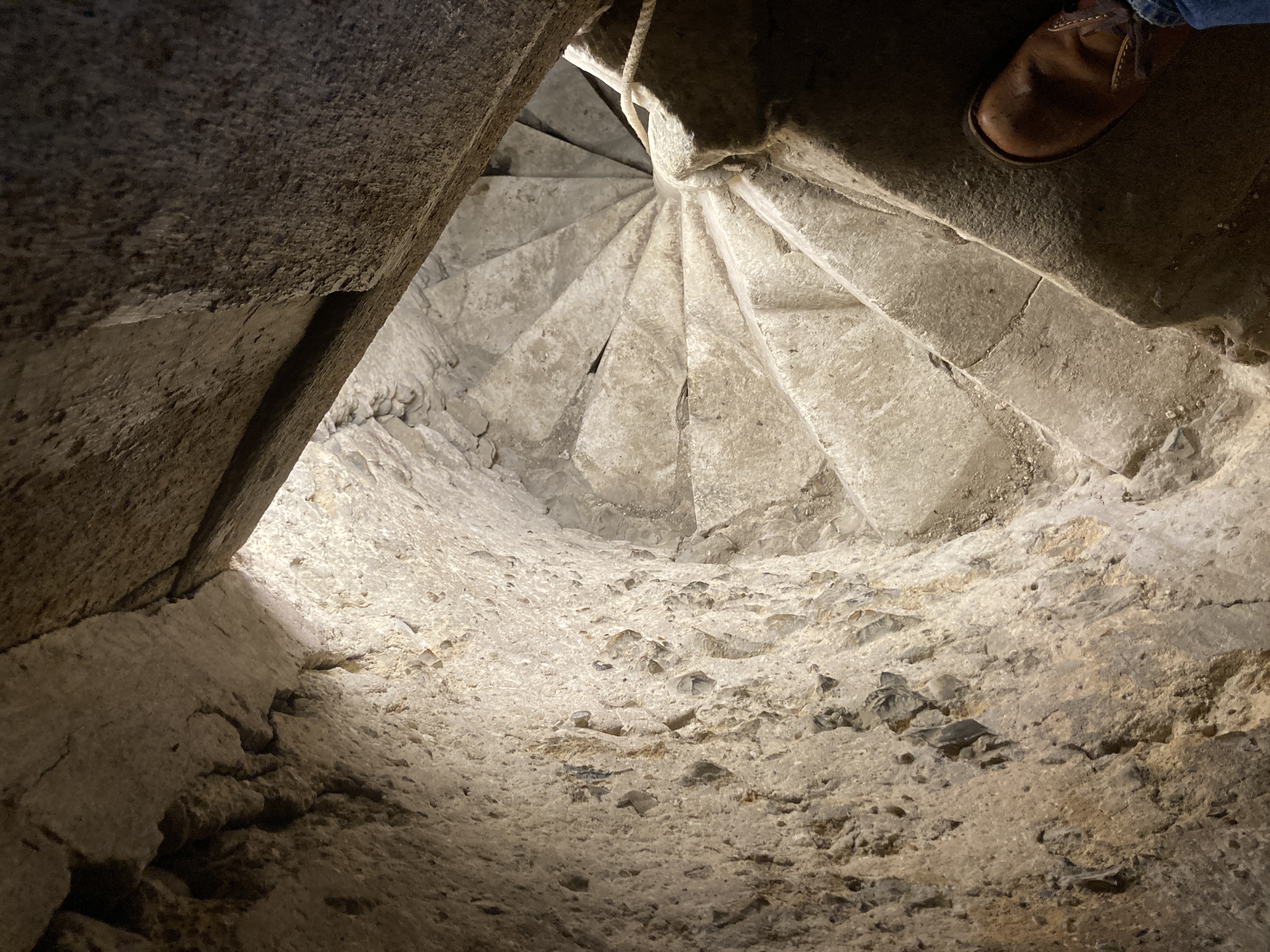
Top of spiral at Yaxham
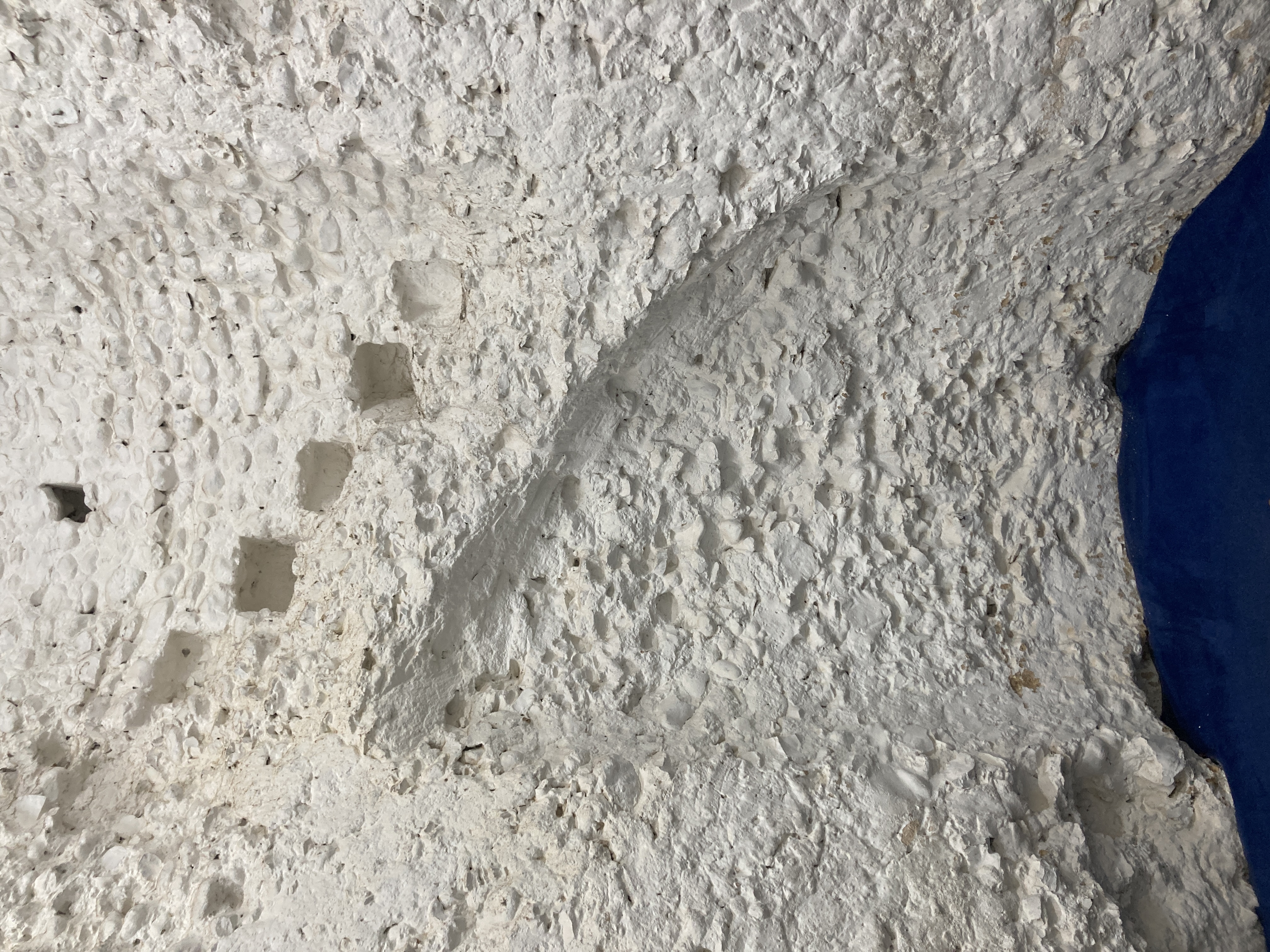
The remains of the top of spiral at Ryburgh
**********
April/May2025
The two columns for these months have been expanded and appear as a separate page under the title:
A Saxon Church : To be or not to be
**********
June 2025
From the Bell Tower
As I trace the history of the building of St Andrew’s I am naturally drawn to the
history of the use and interpretation of the Christian faith that it has accommodated
throughout its extraordinarily long history.
I have written quite a lot, most especially on the this website, of the friction resulting from zealous
clergy attempting to force rather than accommodate parishioners in the late 19th
Century, as personified by Morris Fuller. All he was doing was to try to promote the
ideals of the Oxford Movement as he saw it. That considerable faction in itself was in
response, to a broadly complacent establishment with a flagging antiquated
infrastructure, and partly for the need to meet the requirements of the new parishes in
towns and cities that grew out of the Industrial Revolution….. never forgetting of
course that Dissenters of all other persuasions needed to be discouraged or quashed.
So what might this have to do with my recent Ebay purchase of two volumes that
were once owned by an otherwise unknown Lydia Blanchflower. who put her name
into both volumes on Nov 1st. 1803, although they were not new then by any means,
bear the printing dates of 1728 and 1735. They were a 9th and 5th edition of the
works of the Revd. John Tillotson, late Archbishop of Canterbury who died in 1694.
King William lll at Tillotson’s funeral spoke thus of him: “he had the brightest
thoughts and the most correct style of all our divines, and was esteemed the best
preacher of his age."After his death, Tillotson's wife, Elizabeth French who was
Oliver Cromwell’s niece, sold his sermons, which make up the bulk of the writings
in these volumes, no longer having a husband to provide for her.
John Tillotson was born into a Yorkshire Puritan family in 1630, educated first by his
father, a clothier, then grammar school and after at Clare Hall, Cambridge. He began
his preaching career at Lincoln’s Inn in London and soon gained a reputation as a
preacher.

He wrote zealously against the Catholic Church especially in a work entitled “Rule of
Faith” and in very specific discourses against Transubstantiation and Purgatory. Such
works eventually resulted in preferment by appointment of William & Mary to the
position of Archbishop of Canterbury in 1691.

Following the most turbulent century in the Church’s history, his own story coincides
rather curiously with what is so neatly lampooned in the satirical song “The Vicar of Bray”.
Tillotson himself seems to have skillfully negotiated his career in similar fashion to the
incumbent of Bray but the fact that his work was still being disseminated well into the
C19th. bears testimony to his influence on the C.of E. for many years after his death.
For those that don’t know the song, the first verse goes as follows:
In good King Charles's golden days,
When Loyalty no harm meant;
A Zealous High Church man I was,
And so I gain'd Preferment.
Unto my Flock I daily Preach'd,
Kings are by God appointed
And Damn'd are those who dare resist,
Or touch the Lord's Anointed.
And this is law, I will maintain
Unto my Dying Day, Sir.
That whatsoever King may reign,
I will be the Vicar of Bray Sir!
So by way of a reminder of what may have been the liturgical flavour within the
walls of St Andrew’s during the incumbencies of Rectors from John Spencer 1687,
through to the often absent Charles Mordaunt, I would say that anyone reading this is
welcome to come and have a read through these two substantial volumes, containing
in one volume, 200 sermons and discourses with 54 including his Rule of Faith in
another. Just drop us a line to make arrangements. In spite of their being 300 plus
years old they are not particularly rare as these thing go and cover boards apart are
still in pretty good condition. Also, from what I have encountered to date, they are
infinitely more readable than the diatribes of Morris Fuller on his favorite topics such
as “The Tripartite Division of Tithes” which you can also have a look at (though only
in facsimile) if you felt so inclined!
You can nevertheless sample, bound in 18th century blind embossed leather with six
raised bands, in small folio size: “The Wisdom of being Religious” or “The Folly of
Scoffing at Religion”
You can heed or rail against “The Hazard of being saved in the Church of Rome” or
“A Persuasion to Frequent Communion”
There are also texts aimed at Institutions such as the House of Commons (N.B.
Preached on November 5th 1678) or to the Assizes and those preached in person to
Charles ll or for Our Deliverance by the Prince of Orange in January 1688.
I hope someone will be sufficiently interested to give them a look, since they must
have been spiritual sustenance for many generations in the past.

P.S. I was particularly interested to find several pages against atheist belief carefully
argued with reference to either the “Epicurean Atheist” or the “Selective Atheist”
point of view. Not that I know about these things but it was a surprise to find the
word Atheism in writings of the 1680’s, but it is clearly much earlier Classical
philosophical material that in other circumstances, I would have thought even then to
be pure heresy with consequences!
**********
July 2025
From the Bell Tower
I apologise, though only a little bit, for returning again to the missing spiral stair in
the tower. The reason being that I have had the chance to see and climb a late
Saxon/early Norman barrel-vaulted helical stair (as is its correct description) still
intact in its circular turret. For me it was the sort of event that made my day and
satisfied my curiosity as to how the central newel of such a stair was formed. This
rare and remarkable structure is to be found in what has been described as “the most
impressive pre-Viking church still standing in England” otherwise recognised as All
Saints, Brixworth in Northamptonshire. If you have never seen or heard of it, I would
say that you could not fail to be captivated by this extraordinarily old church, and if
you ever have the opportunity to visit you really should do so…...but then given the
spiral stair I am perhaps not entirely unbiased in the matter!
A huge amount of study has been given over to the history, architecture and building
materials of Brixworth church and as often happens in church towers, as they are not
generally so much in the public domain, there is less by way of “make-over” and
more “make do and mend”. And so by this means their stair is still in place and
functional, giving access to the ringing chamber in the tower.
We of a certain generation probably became used to seeing a space shuttle clinging on
to a rocket on the launch pad but it is nevertheless still a real surprise to see a round
stair turret clinging shuttle like to a square tower topped with a spire. That
nevertheless is the view from the south that greets you as you go up the hill on which
the church stands.

Whilst the earliest iteration of All saints is believed to have been in the 9th Century
quite a lot of it was constructed from re-used Roman tile and many other types of
stone, both recycled and fresh quarried locally or imported. The monumental study of
the church published in 2013 places the stair in the turret in the “late Saxon” period.
This still uncertain dating comes from the work of David Parsons, one of the authors
of the monumental study of Brixworth. In 1978 he had published in a German
Archeological journal a paper on barrel-vaulted staircases in England and on the
Continent. He cites just 11 of the 43 Continental helical stairs, of which he was aware
at the time, as being of barrel vaulted construction. Of these just over half dated from
the 1st half of the 11th Century and only one, found at Aachen, that dated from the
early 9th Century and with others dated later into the 12th Century. Which means the
skills that were on the Continent pre-conquest and later, could have been just as
common here. The problem being however the lack of pre-conquest buildings to bear
this out. So as far as Ryburgh’s stair is concerned it could possibly be of pre-conquest
construction, but it is safer to say after 1066.
The remains at Ryburgh are confined to the interior of the outer walls of the turret, i.e
that there is no evidence of the form of the newel in the centre. Brixworth
demonstrates that the rubble built newel is made as part of the vaulting and in the
process creating a central column about 2 feet in diameter.
The barrel-vaulted helical stair at All Saints' Brixworth.
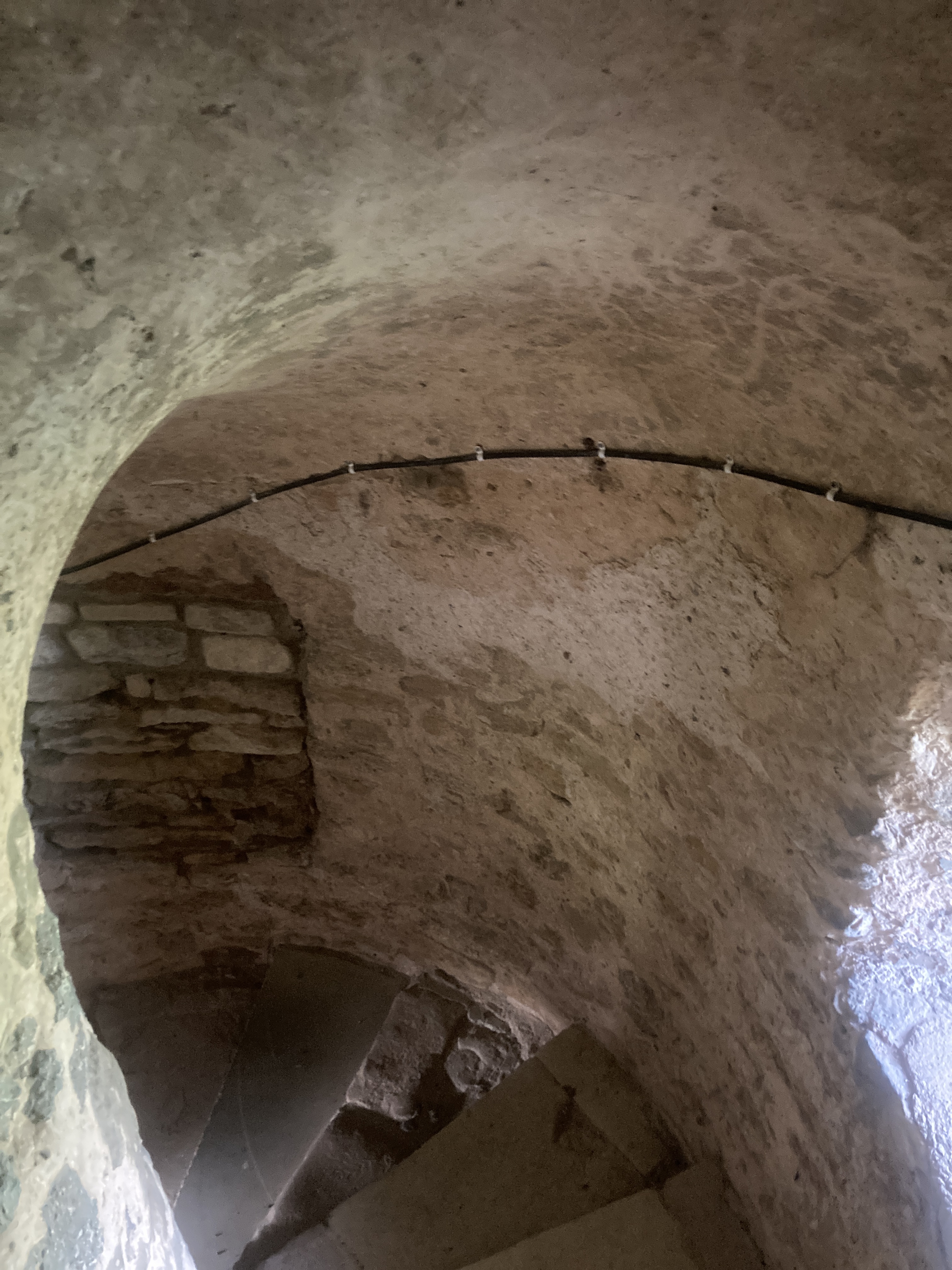
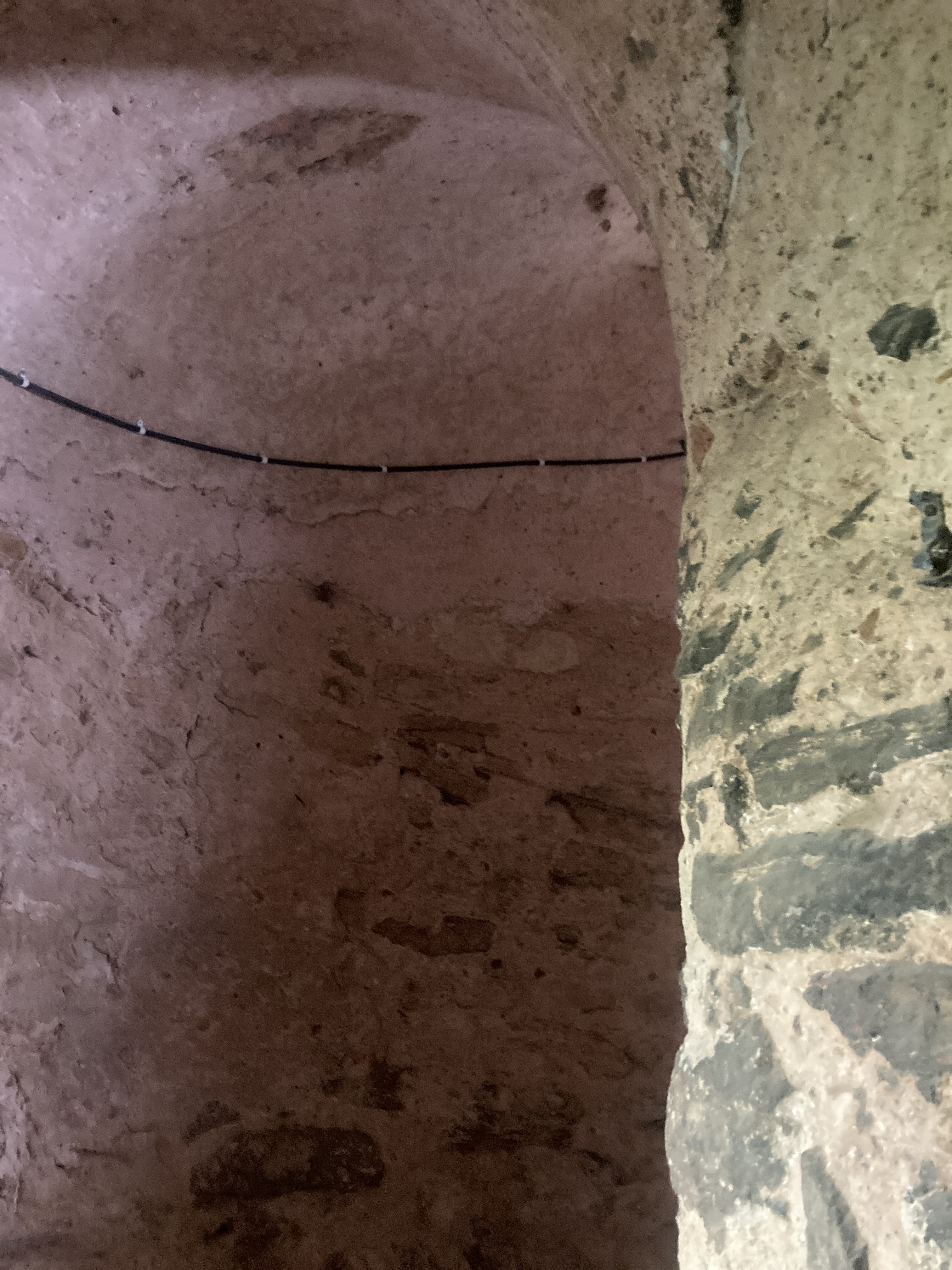
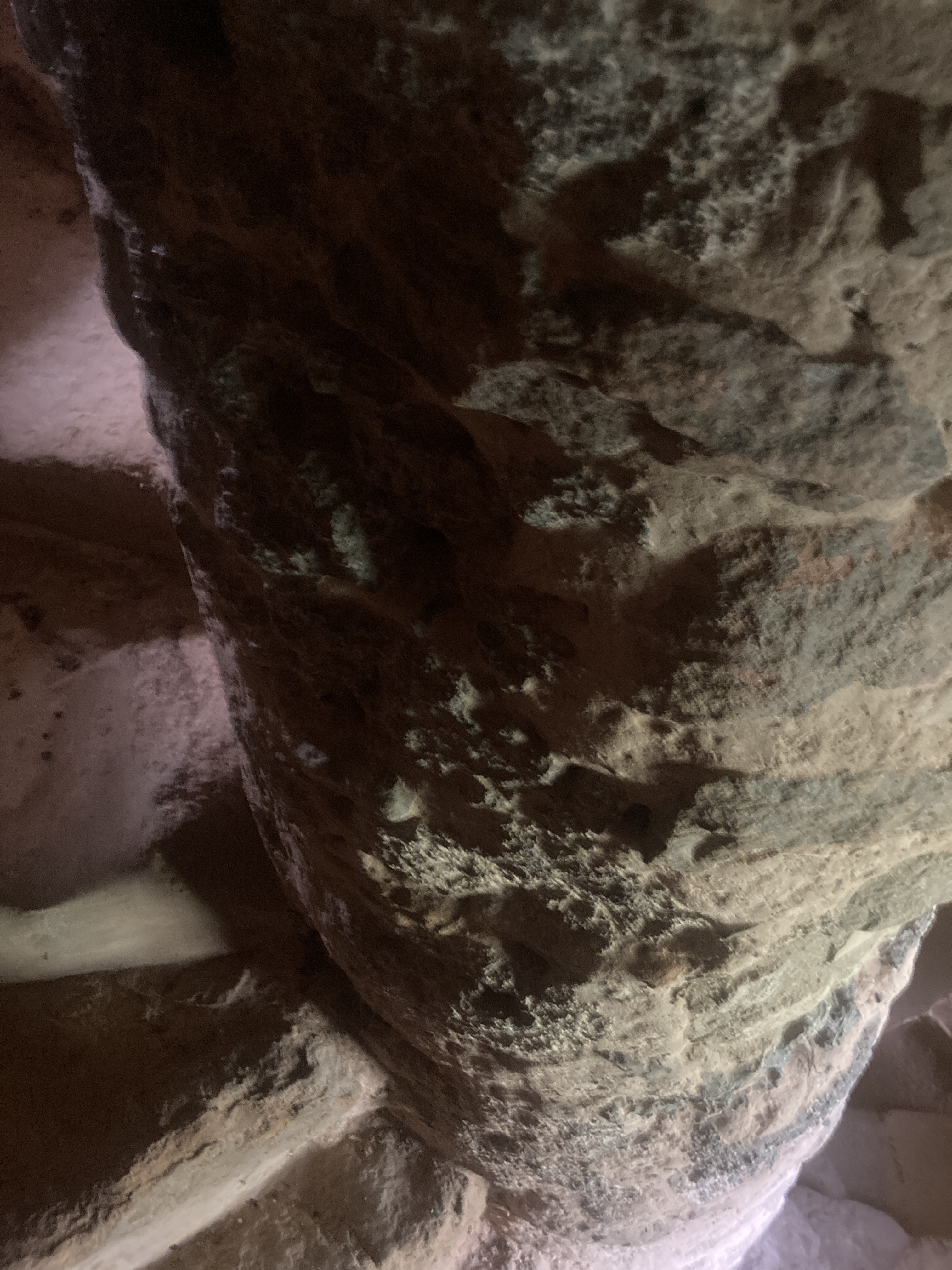
Were this the case at Ryburgh, the dimensions suggest a central newel of about 20
inches. Until I read David Parson’s paper I had not realised two major characteristics
of this stair type. The first being that some have totally independent newels with the
vaulting wrapping itself around the column as it rises. The second is that after the
barrel vaulting has been constructed, the stair treads that are bedded on to it (be they
wood or stone pieces) are in some instances not built either into the outer wall or the
newel at all. At Ryburgh we can be sure they were set in the outer wall and due to the
regularity of socket size be fairly certain they were timber but can also be sure that
they need not have been incorporated into the newel however it was formed. Given a
sufficient quantity of good quality conglomerate or well chosen flint, Ryburgh’s
newel could have been totally independent or formed as part of the vaulting
construction process but this we are unlikely to ever know. What is quite clear is
that we belong to a pretty small and select group of early church buildings known to
have such a helical stair and as far as I know, the only round tower so furnished.
As an interesting postscript, if you go to North Elmham to the ruins of the early
chapel/cathedral/Bishop’s palace you will see the first six treads of the stair turret to
the West tower. It is dated possibly to the second half of the 11th Century but
regrettably insufficient height remains to know if it was barrel-vaulted.
H.M.Taylor and Joan Taylor as part of their life’s-work, 1965 publication “Anglo-Saxon Architecture",
observed the following:
"It should be noted particularly how the central newel has been formed separately from the treads and how,
although all the sections of newel have been robbed away, their impressions remain clearly in the concrete
rubble which supports the treads."
Being geographically close by, constructed of similar materials and of very likely similar date , it is very interesting to
see a little more of what might have been at St Andrew’s.
The stair turret to the West Tower at North Elmham.

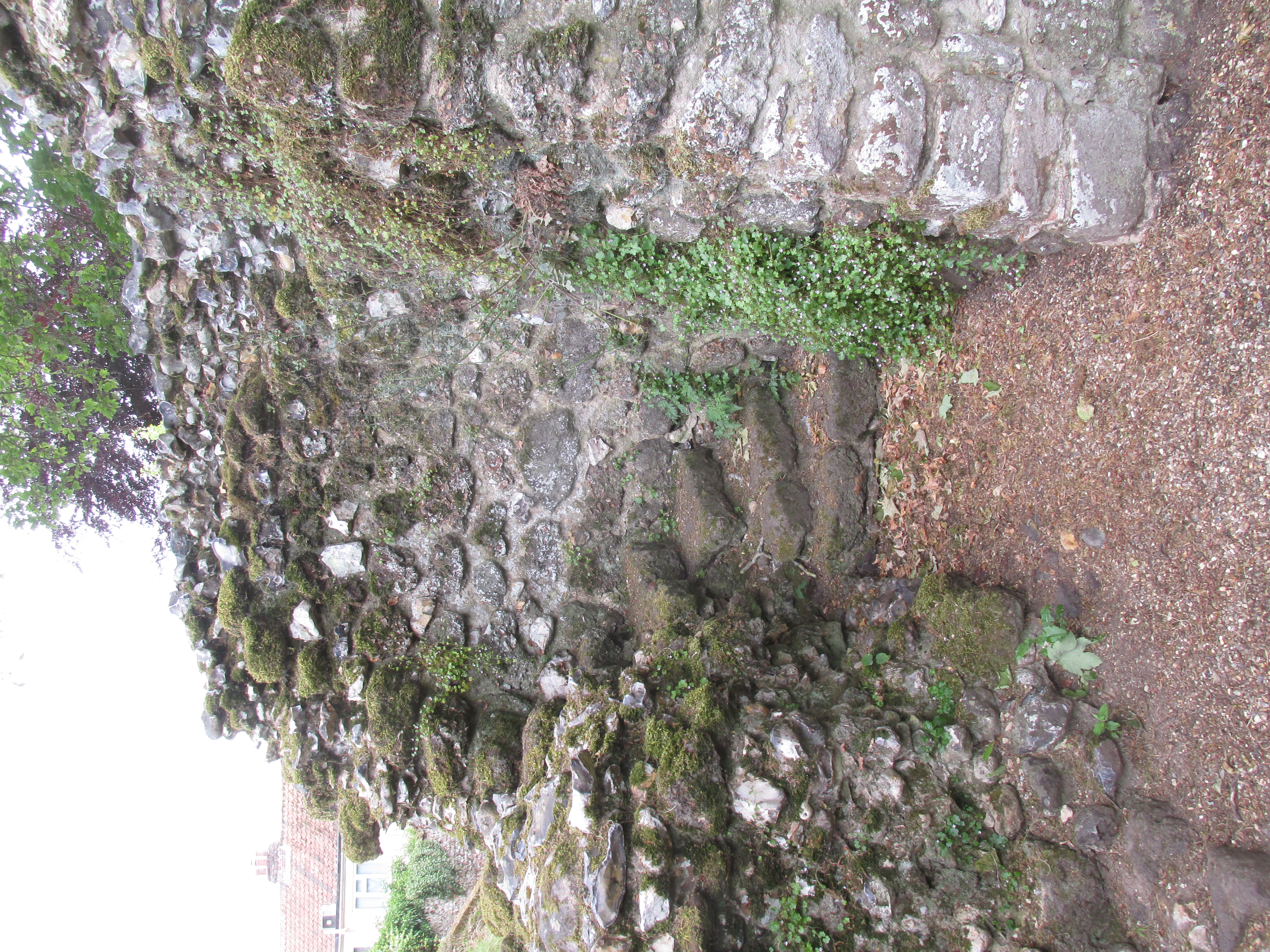
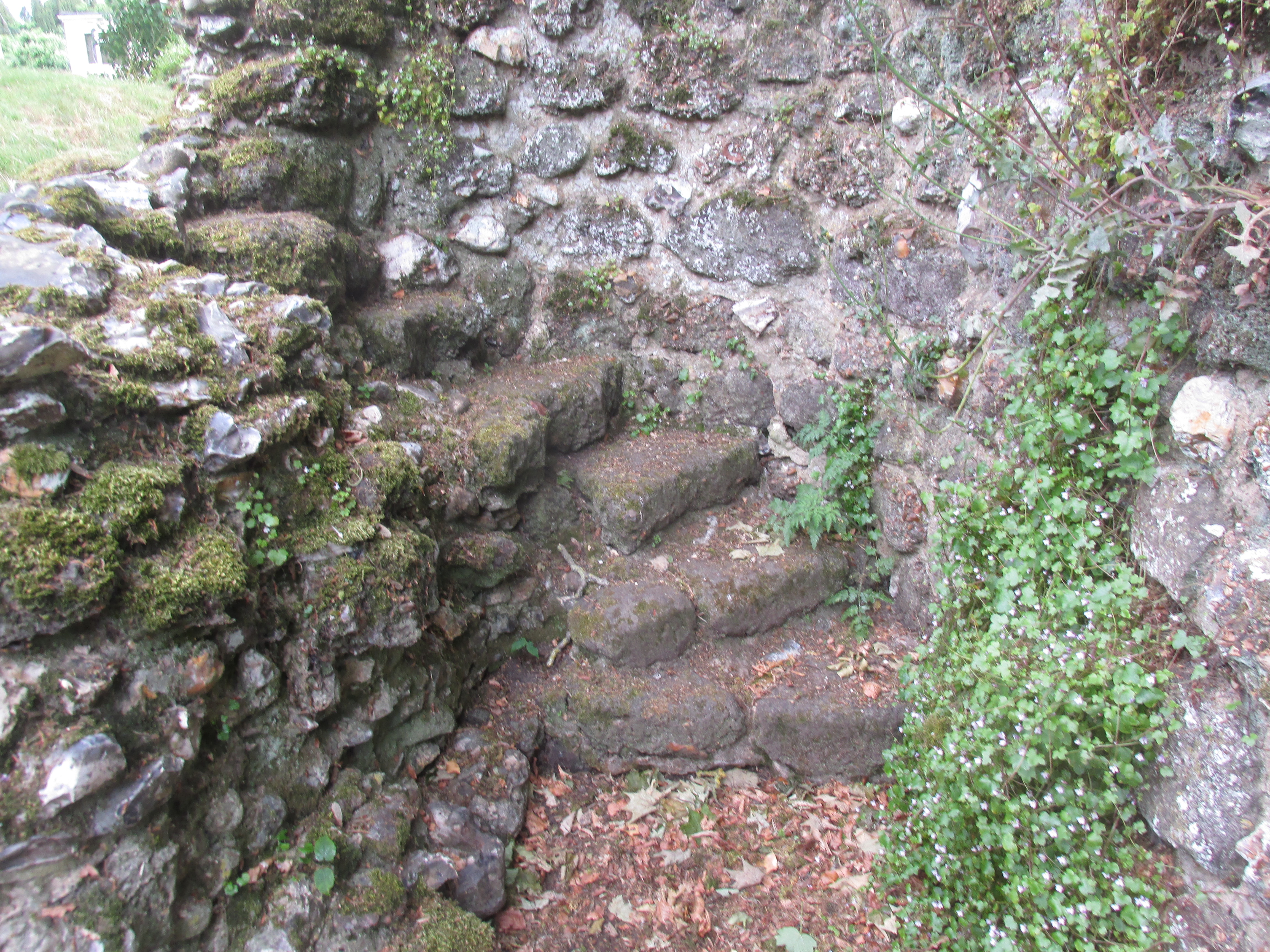
**********
August 2025
From the Bell Tower
How many readers remember the Middle-Saxon Cemetery that was discovered in the 2016 excavation of the Fishing Lake at Mill Lodge Farm. Well, after many years the results of the archeological dig are beginning to be published, starting with the “Tree-ring Analysis of Oak Timbers” by Ian Tyers. The most significant and valuable result from this analysis is reported thus:
“It is a unique English tree-ring sequence since it covers the entire fourth century AD, and thus closes the gap between the Roman sequences ending in the later third and early fourth century AD and the Saxon sequences that typically begin in the early fifth century AD.”
Eighty four grave sites were found of which 74 contained coffins hollowed out from tree trunks in various states of preservation many containing skeletal remains, six others were made of oak boards and the remainder contained no wood. There is much more to be revealed over the coming months and I shall keep you posted.
After the archeologists had completed their work, the remnants were left for the Boyce family to deal with. In practice that meant removing them from the site and putting them into dry storage whilst they completed the construction of the lake. Following the death of patriarch and former West Ham footballer, Ronnie Boyce, the family kindly donated one of these remaining coffins to St Andrew’s in his memory.
To be sympathetically housed in the church requires more than just a place to put it. This happened in the distant, more unregulated past with the heavy stone coffin that is to be found in the chancel. That stone coffin has nothing to do with the “younger” Bridget Buttes altar tomb of the 1570’s and illustrates the importance of the context of any artifacts displayed in the church.
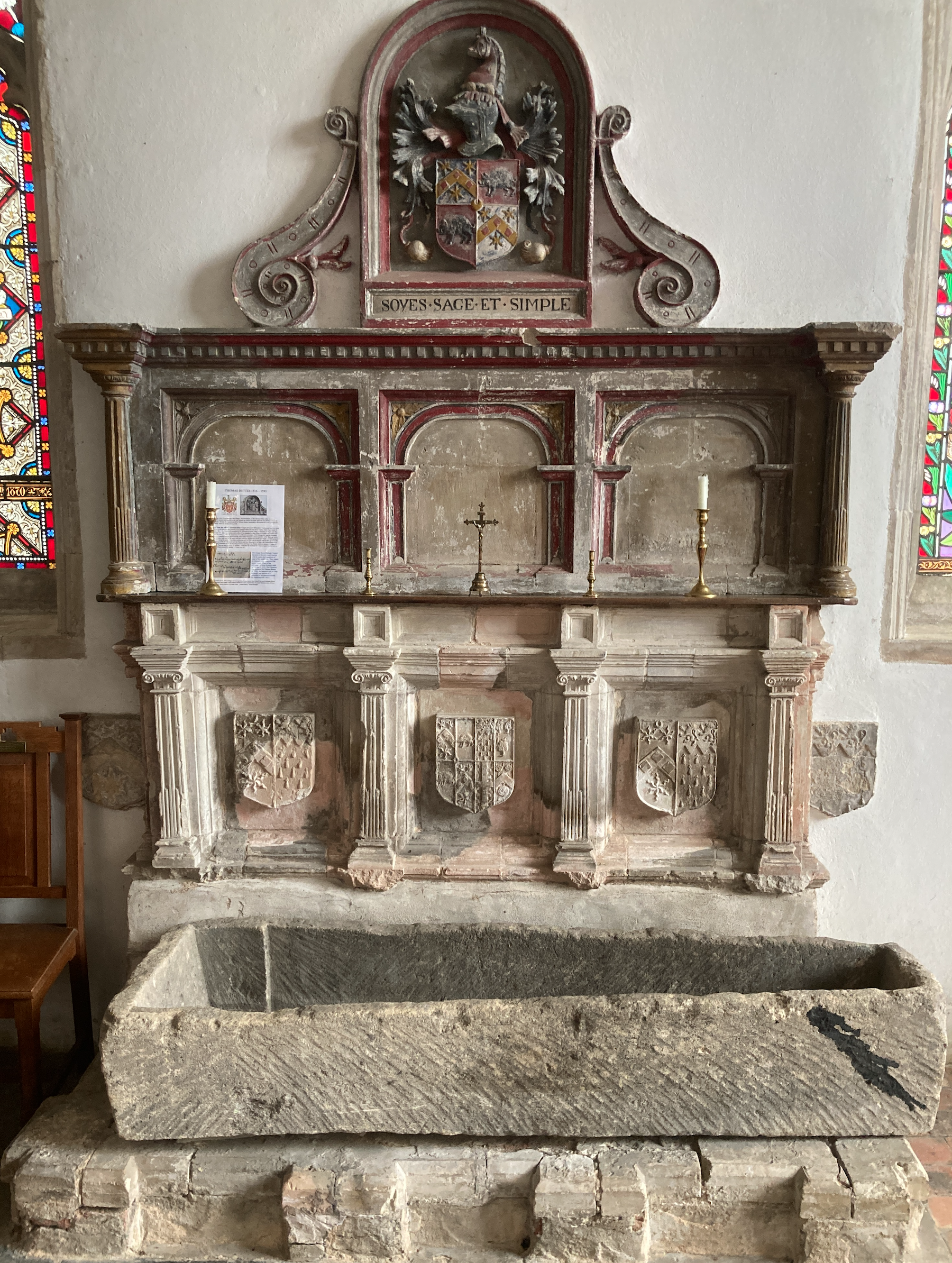
The heavy stone coffin "parked" on the base of Bridget Buttes' tomb
We had to start the process somewhere and with it, a choice to make between two coffins, one which was initially donated that is large and impressive, but unidentified after removal from its original position and a smaller example identified by Matt Champion as 2602 on the dig site plan.
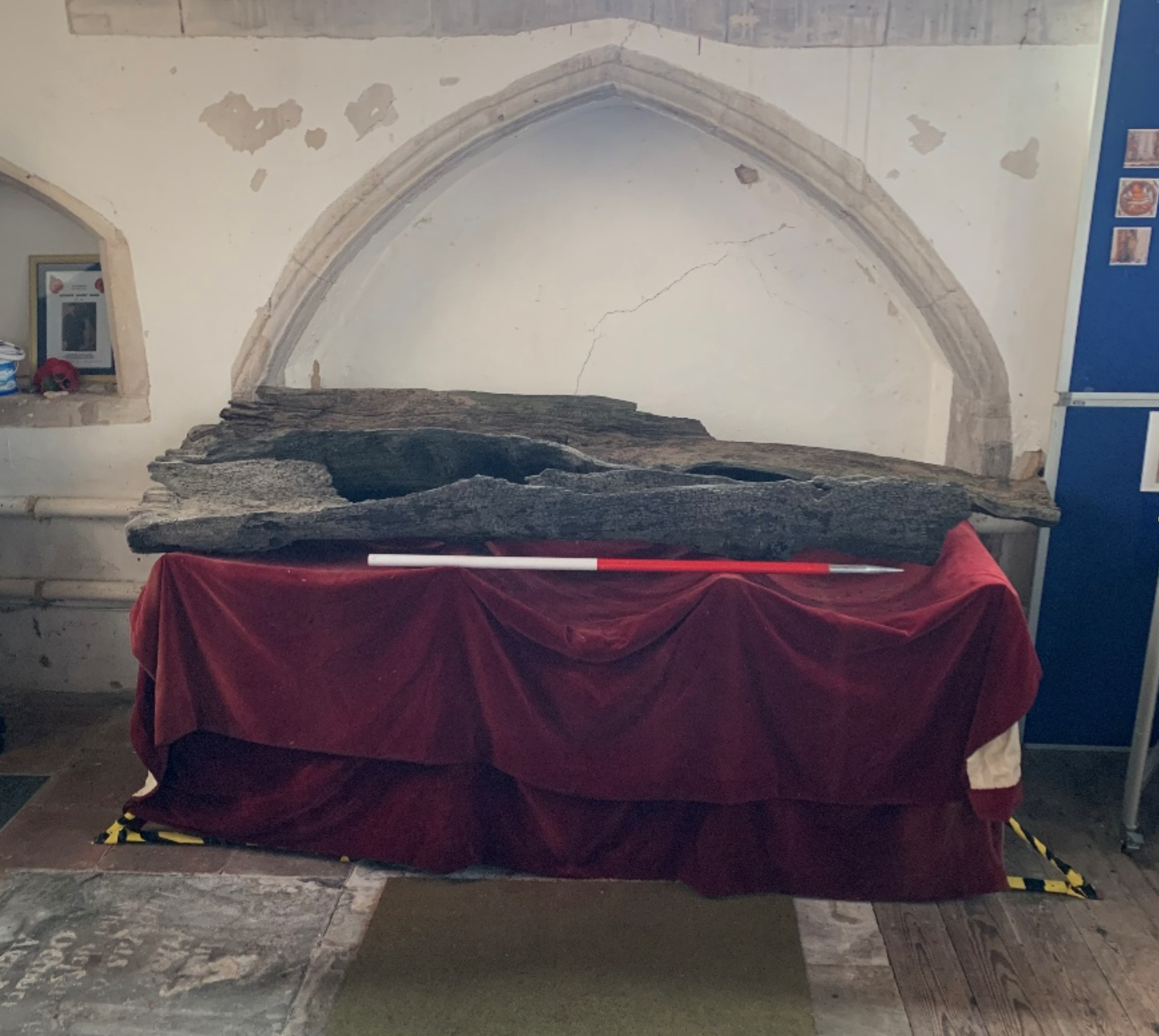
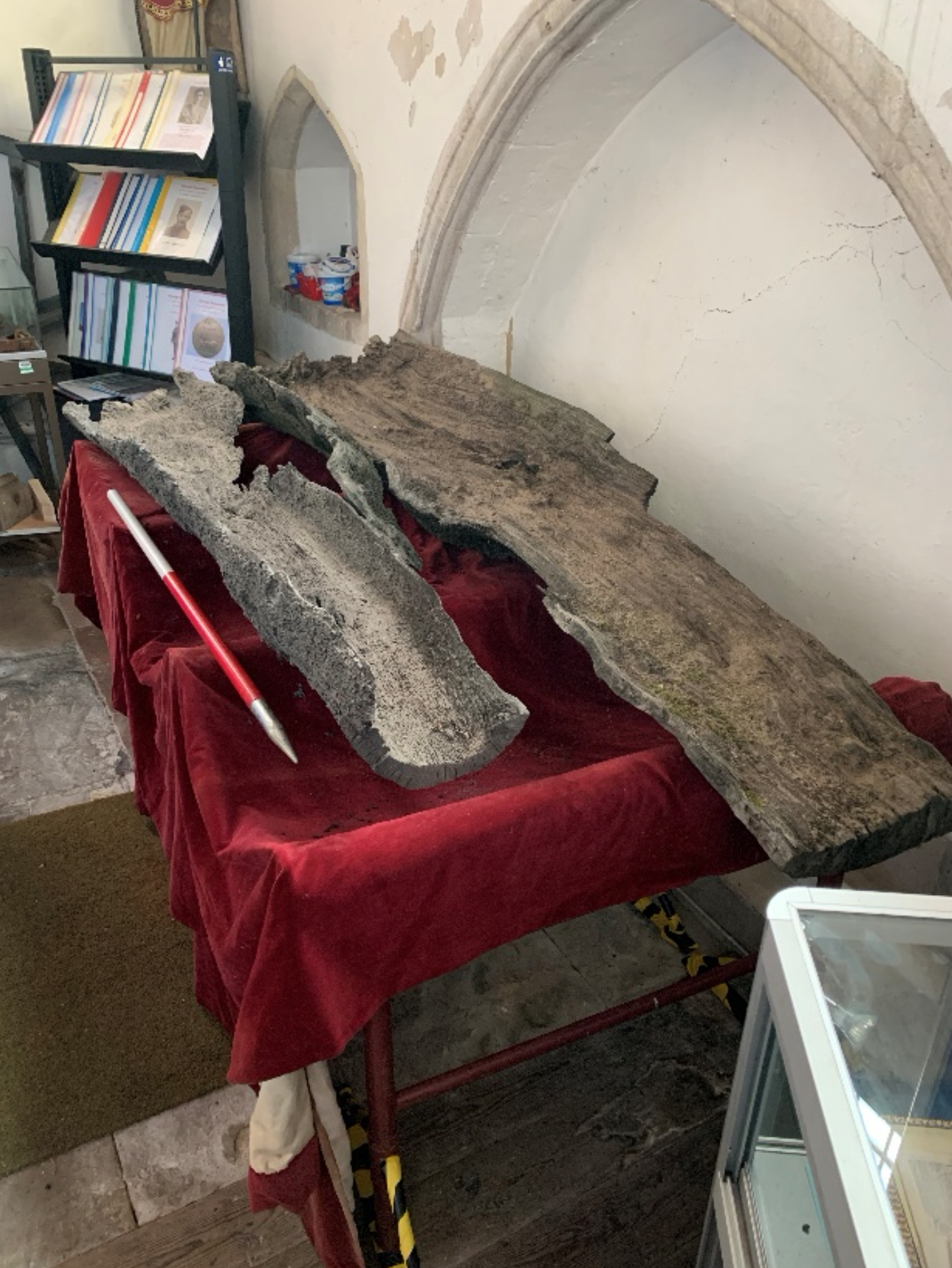
There should be information which the archaeologists have been able to glean from the skeletal remains it once held, and so ticks the context box. The next step in the process has been to obtain a “Conservation Report and Strategy for display”, and this was carried out on 9th. July by York Archaeological Trust’s timber specialist, Steven Allen.
Feedback on the day was most encouraging and his recommendation was for coffin 2602 on several grounds.
The initial draft proposal was to re-inter the coffin’s skeletal remains in the floor of the South transept, in front of the Tomb Arch under the South gable window. The coffin, possibly in some form of environmentally controlled display case, to be in the floor above the bones, finishing flush with the floor under plate glass. The information boards and other exhibition items would be in and around the Tomb Arch itself.
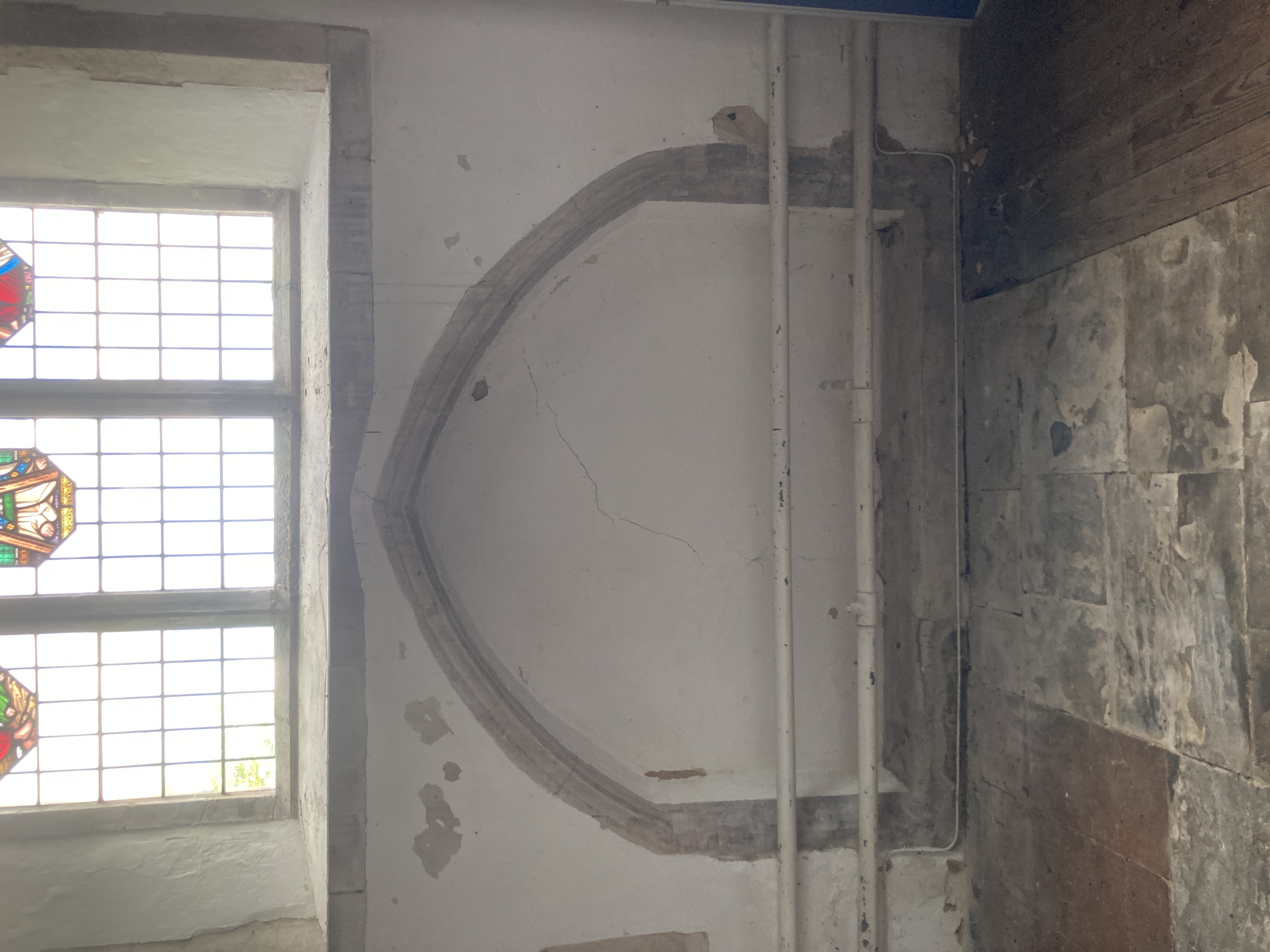
The Tomb Arch under the South gable window.
Steve Allen cautioned against this, amongst other things on account of the inevitable considerable expense of what would need to be treated as an archaeological dig in the light of the probable remains of the once occupant of a long gone effigy that would have once laid east to west within the arch.
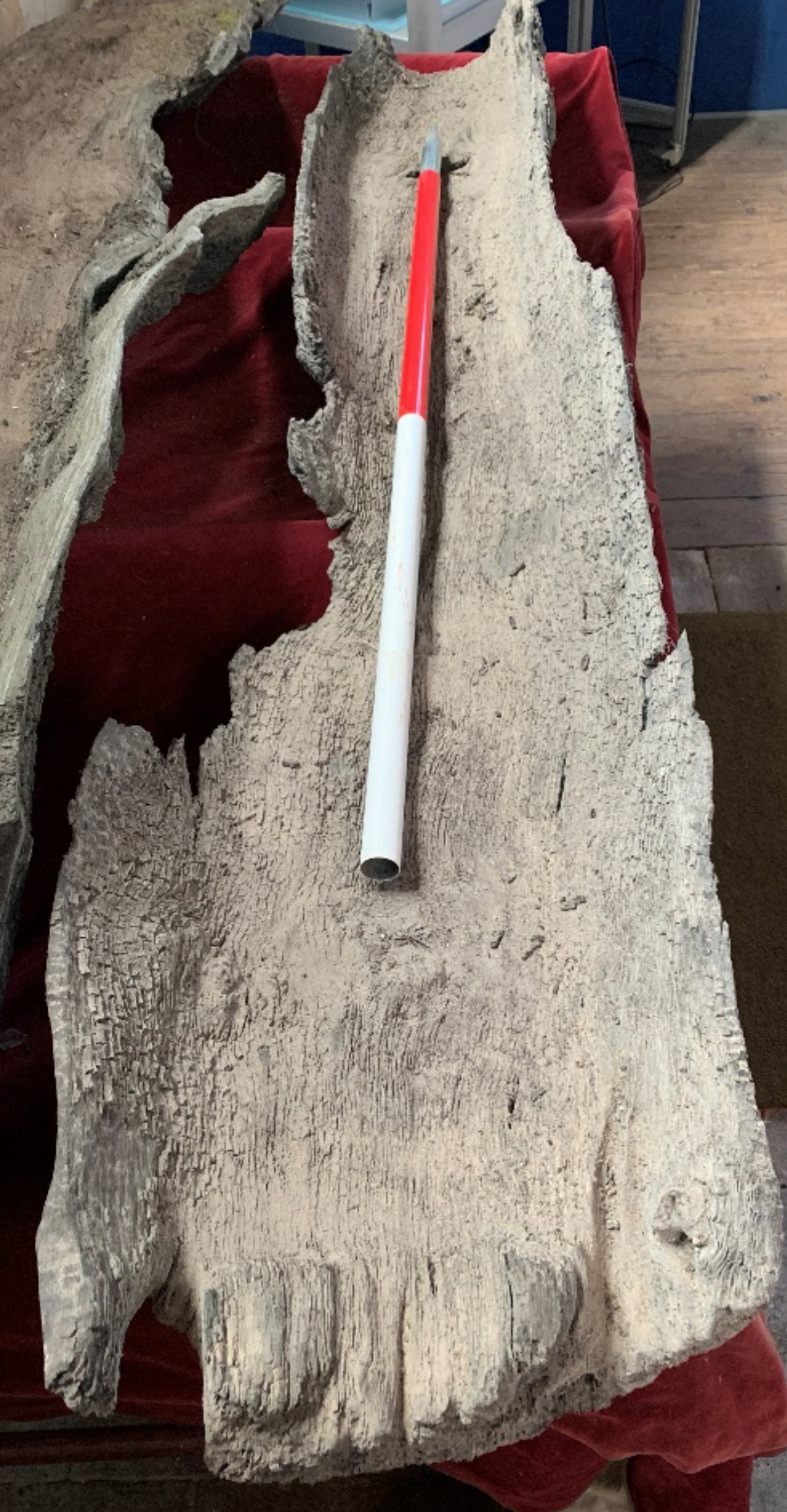
Coffin 2602
Coffin 2602 is of a length that could once again see an occupant of the Tomb Arch and so Plan B comes to life which would involve the coffin placed within the arch space, quite possibly even without a display case. The skeletal remains to be placed beneath in a box constructed with the partial use of some of the remaining fragmentary coffin pieces. The heating pipes to be insulated in the area immediately in front of the Arch and draped fontal like as a staging. Information boards and other exhibition items would be displayed suitably around the exhibit as space allows.
The written report, as expected, was entirely positive, recommending “Plan B” that should result in a mercifully low cost scheme with maximum visual impact as a feature of t he South Transept. It is therefore with all this to hand we can now get on with the business of applying for the Faculty.
**********
September 2025
From the Bell Tower